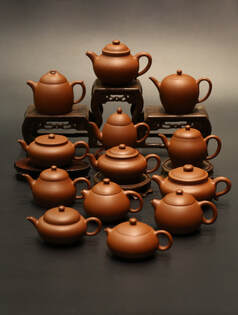Yixing Teapot Pairing or Which Tea for which teapot?

(Originally published December 16, 2020)
One of the most popular topics we receive questions about is pairing teas with Yixing teapots. This is understandable as the purpose of using an Yixing Teapot is to complement the flavour of tea.
While we do have some suggestions for tea pairing, they come with the following caveat: These are rough guidelines and reflect our personal tastes and opinions.
The spectrum of Yixing teapots consists of zhuni, hongni, zini, duanni/luni (or "red, brown, yellow"). Zhuni will have the least affect on flavour and is good for concentrating aroma. Hongni (including jiangponi) will mute certain flavours more, but not as much as zini. Zini will mute more flavour, but not as much as duanni and lüni.
We always recommend trying a new teapot with as many different kinds of tea as possible. You may be surprised by what goes well with a certain kind of clay.
Yixing Teapots for Green Tea
We prefer to use porcelain or glass for Chinese green tea in most cases. Gentle green teas like Longjing do better when their full flavour is allowed to come out. They also require lower temperatures, and do not require the high heat retention of most zisha.


Longjing green tea brewed in a porcelain gaiwan.
Yixing Teapots for White Tea
We prefer to use porcelain for new higher grade white tea (Silver needle, Baimudan).
For heavier flavoured white tea such as Shoumei, and aged white teas, we find they do well in zini. The heavier flavour does well in this clay, is made even smoother without losing any of its sweetness.


Fuding white tea on the left and dicaoqing (zini) teapot on the right.
Yixing Teapots for Black Tea
Depending on the black tea, it may do well in zhuni, jiangponi or zini. In general, we find the more delicate black teas do well in zhuni, while those with more astringency or smokiness do better in zini.


Dalunshan high mountain black tea on the left and zhuni and tianqingni (zini) teapots on the right.
Yixing Teapots for Oolong
Lighter “Green” Oolongs
For unroasted, lightly oxidized rolled oolongs (Taiwanese High Mountain Teas, greener Dong Ding, etc.) conventional wisdom holds that zhuni is the ideal clay, and we agree. Zhuni rounds very little if any of the flavour and is less porous than other zisha. Zhuni is good for concentrating the aroma of tea. A tea with a more subtle flavour – layered and rich – does better in zhuni.


Taiwanese high mountain tea on the left and zhuni teapots on the right.
Dark Oolongs
For roasted, more heavily oxidized and aged oolongs, we usually recommend choosing a darker clay – Jiangponi or a type of zini in most cases. Generally speaking, Jiangponi containing more hongni (also referred to as “Jiangpo-hongni”) is less muting than zini. Zhuni is still preferred by some. If you want to preserve the full flavour and concentrate the aroma, then zhuni may be a better choice.


Aged and roasted oolong tea on the left and a jiangponi teapot on the right.
Yixing Teapots for Pu'er
Sheng Pu’er
For nice young sheng pu’er – sheng with a complex, layered flavour, as well as sheng that is softer and smoother – we recommend using a zhuni teapot. We like to concentrate the aroma of these teas and wouldn’t want to mute any of the flavours.
For semi-aged and stronger tasting younger sheng pu’er, we recommend using jiangponi (jiangpo-hongni) or zini. For those teas requiring less muting of flavour, we recommend jiangponi, for those teas with harsher notes we recommend choosing a zini teapot, or even a duanni or lüni teapot.


Young sheng pu'er on the left and zhuni teapots on the right.
Aged Sheng
For an aged sheng without any strong storage notes, we recommend trying the tea with both a zhuni and a zini teapot. A nicely aged sheng may be quite smooth already and may not need the muting effect of a zini teapot. Zhuni will present the full flavour of the tea and concentrate the aroma. It is also worth trying aged sheng with a zini teapot, as it may lessen certain notes revealing other underlying flavours. For an aged sheng with some storage aroma, we recommend a zini teapot to help bring out some of the subtler notes of the tea. We like to use Zhuni and our TianQingNi shuiping (a subtype of zini) for aged sheng pu’er.


Aged sheng pu'er on the left and tianqingni (zini) teapot on the right.
Shu Pu’er
In our opinion, shu pu’er does best in zini, duanni or lüni. For shu pu’er with storage aroma, duanni or lüni will do more to mute the harsher notes and smoothen out the tea. Duanni and lüni tend to be the most porous and the best for heat retention, both characteristics that work well when brewing shu pu'er.


Shu pu'er on the left and benshan lüni teapot on the right
